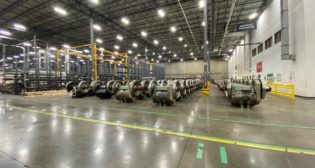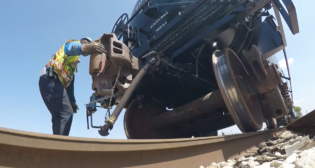
Fleet revitalization
Written by William C. Vantuono, Editor-in-ChiefThe freight car fleet has been growing for four years running. It’s also getting younger.
The revenue-earning railcar fleet is a subset of the North American railcar fleet that is largely composed of freight cars that can be used in interchange service and against which an interline waybill can be placed. It is made up of six sub-fleets: hoppers, covered hoppers, gondolas, flat cars, tank cars and boxcars. (It excludes locomotives, intermodal trailers and containers, maintenance-of-way equipment and end-of-train devices.)
Railinc’s annual review of the North American revenue-earning railcar fleet shows the fleet continued its growth in 2014. The total size of the revenue-earning fleet increased for the fourth consecutive year—adding cars in the tank car and covered hopper sub-fleets, while the flat car, boxcar and hopper sub-fleets contracted. The average age of cars in the revenue-earning fleet declined for the third year in a row, suggesting more new cars are joining the fleet as older cars exit.
Railinc’s analysis of the fleet is focused on highlighting trends and changes.
KEY FINDINGS
 The revenue-earning fleet increased in size in 2014: The growth rate increased in 2014, and the fleet surpassed its 2009 population level. The total fleet size is up 2.6 percentage points from year-end 2013 to year-end 2014, compared with a 0.9% increase the previous year.
The revenue-earning fleet increased in size in 2014: The growth rate increased in 2014, and the fleet surpassed its 2009 population level. The total fleet size is up 2.6 percentage points from year-end 2013 to year-end 2014, compared with a 0.9% increase the previous year.
An increase in the tank car population drove growth in the revenue-earning fleet. Tank cars and covered hoppers, the two largest sub-fleets, increased in numbers in 2014, while gondolas were unchanged. Hoppers and boxcars, the two smallest sub-fleets, continued their decline.
The average age of the revenue-earning fleet decreased slightly in 2014, for the third consecutive year, going from 19.9 years to 19.8 years. The decrease suggests more new cars are joining the fleet as older cars exit.
The trend of 286,000-pound gross rail load (GRL 286) cars predominating among additions to the revenue-earning fleet continued in 2014. The number of GRL 286 cars added to the fleet in 2014 was about 25% more than in the previous year and the most in a decade. Larger cars enable operational efficiencies that reduce costs and ease logistics challenges.
REVENUE-EARNING FLEET GROWS
The revenue-earning fleet increased by 40,000 cars in 2014, surpassing its 2009 population level. At the end of 2014, the revenue-earning freight car fleet totaled 1.553 million units of equipment, up 2.6% from the previous year (Figure 1). Tank cars again drove growth in the revenue-earning fleet, increasing by 9.4% over 2013. Covered hoppers were up 2.9%, while gondolas were unchanged. In contrast, boxcars (including refrigerated cars) were down 2.6%, hoppers by 2.1%, and flat cars by 0.5%.
The average age of railcars in the revenue-earning fleet continues to decrease slightly. In 2014, the average age was down 0.1 years, to 19.8 years (Figure 2). More new cars were added as older cars left the fleet in 2014. This suggests the economy continues to head in a positive direction since historical data show that fewer new railcars join the fleet during and immediately following economic dips.
More than 50,000 new cars have joined the revenue-earning fleet in each of the past three years, and the number of new cars added in each of the past four years is larger than in 2009 and 2010 combined. Historically, the average age of the fleet and the number of cars added to the fleet mirror the economic environment (Figure 3). When the economy is strong, as in the mid-1990s and mid-2000s, the fleet tends to be refurbished with the addition of new equipment. During periods of recession—such as around 1991, 2002 and 2009—the amount of new equipment added to the fleet decreases significantly.
Over the past 20 years, the majority of new railcars added to the revenue-earning fleet are GRL 286 cars. This trend continued in 2014 (Figure 4). The number of GRL 263 cars also increased by more than 5,000 in 2014, driven by the growth in tank cars.
GRL 286 cars have predominated among new additions to the fleet since the early 1990s because they enable operational efficiencies that reduce costs and ease logistics challenges. The fleet continues to add GRL 263 and GRL 220 cars, but at a much lower rate than GRL 286 cars.
SUB-FLEET TRENDS
Several sub-fleets of similar types of equipment comprise the revenue-earning fleet. This section takes a deeper look into a few of the sub-fleets, including covered hoppers, gondolas, tanks, open hoppers and boxcars. Railinc selected these sub-fleets because they carry commonly shipped commodities and make up the largest percentage of the revenue-earning fleet.
Covered hoppers are commonly used to ship commodities such as grain and plastics. After holding steady in 2013, the covered hopper sub-fleet grew 2.9% in 2014, to 493,000 cars. Covered hoppers are the largest sub-fleet in North America, making up about 32% of the total revenue-earning fleet.
Over the past four years, more than 43,000 new small covered hoppers have joined the fleet—more than all other sizes of covered hoppers combined. Nearly all were GRL 286 cars. Despite the growth, small covered hoppers comprise only 7% of the North American revenue-earning fleet.
Gondolas are commonly used for shipping coal, iron and steel products, and scrap metal. The number of gondolas in the revenue-earning fleet was unchanged in 2014, after decreasing by 1.7% the previous year.
Tank cars carry a variety of products, including food, chemicals, petroleum, and hazardous materials. They make up about 24% of the revenue-earning fleet. The size of the tank car fleet continued its growth in 2014, increasing 9.4%, to 371,000 cars—the largest increase of any of the sub-fleets. The majority of tank cars are GRL 263 cars, although more GRL 286 cars are being added to the sub-fleet. Nearly 50,000 GRL 286 tank cars were added in the past two years.
About 11,000 medium tanks—those with capacities between 22,500 and 27,500 gallons—joined the North American fleet in 2013 and 2014. Of those, about 90% were GRL 286 cars.
About 45,000 large tanks with capacities greater than 27,500 gallons were added to the fleet in 2013 and 2014—more than four times the number of medium tanks added. Large tanks make up 10% of the North American revenue-earning fleet, while medium tanks and small tanks each make up 7% of the fleet.
Open hoppers carry a number of products, including coal, aggregates and metallic ores. The number of open hoppers in the North American revenue-earning fleet decreased by 2.1% in 2014, to 142,000, continuing the sub-fleet’s steady decline.
Boxcars are the smallest sub-fleet of the revenue-earning fleet. They are used to ship a wide variety of products, from consumer goods to automotive parts. The boxcar sub-fleet is older than other sub-fleets and continues to decrease in size, in part because of the addition of higher-capacity boxcars and network efficiencies that reduce the turnaround time of boxcars. The size of the boxcar sub-fleet continued its downward trend in 2014, decreasing to 111,000. It is down 16.5% since 2009.
Railinc is a wholly owned subsidiary of the Association of American Railroads. For more information, visit: www.railinc.com.



